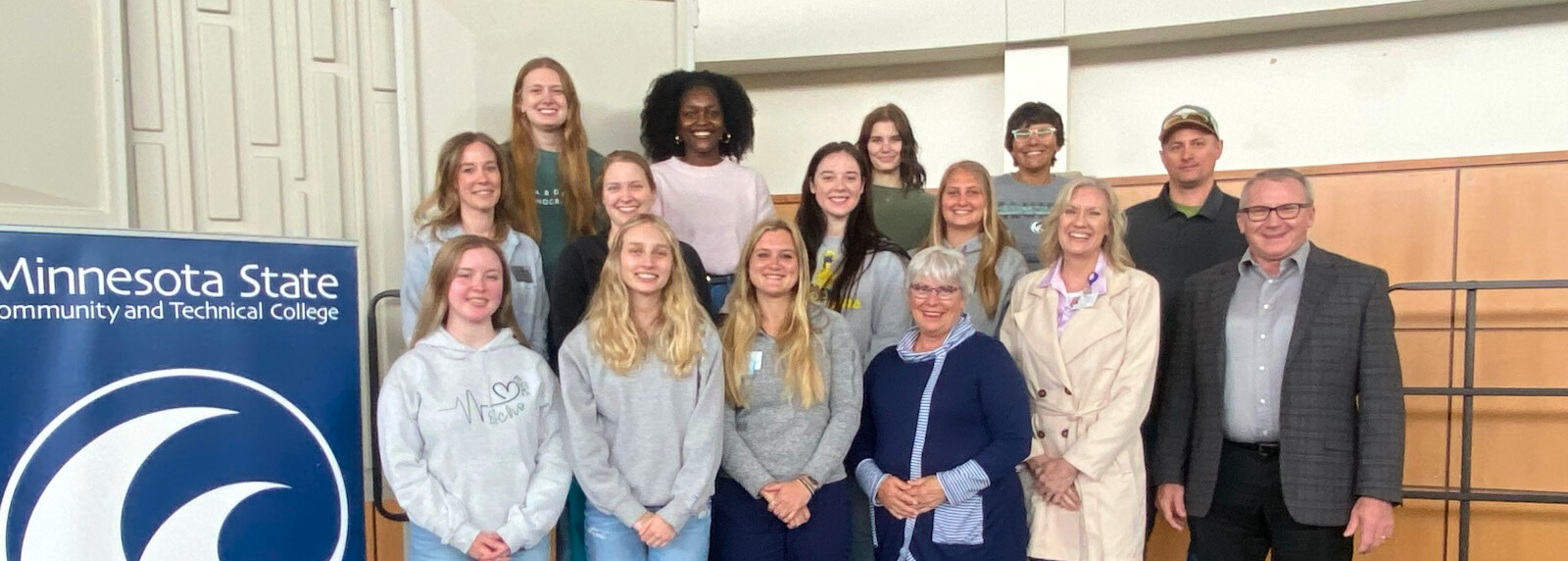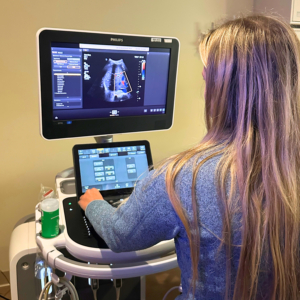
Ultrasound uses high-frequency sound waves to produce images of structures inside the body. Diagnostic medical sonographers and ultrasound technicians use the safe, cost-effective tool to understand the causes of pain, infection, and swelling, and to conduct exams to check the development of a fetus.
The Helmsley Charitable Trust’s Rural Healthcare Program has granted more than $70 million toward ultrasound initiatives in four states, equipping hospitals and clinics with more than 600 devices, offering training opportunities to sonographers, and providing tuition assistance to those looking to enter the field.
To highlight the crucial role sonographers play in healthcare, we celebrate the accomplishments of two students supported by tuition assistance awards. Learn about Rachel Matz’s path to her sonography career in rural Minnesota and Katie Caceres Orellana’s fulfillment of a generational dream.
Rachel Matz has faced down “the big, the bad, and the ugly” at least twice in her life. That’s the name she uses for the persistent gastrointestinal issues she battled in her teens, and for her mother’s abnormal mammogram results. In each case, ultrasound and other advanced medical-imaging techniques gave her the right information at the right time. That knowledge has meant everything to her and her family.

Sonographer Rachel Matz at work.
“Going through appointment after appointment and not getting answers is frustrating,” says Matz, who’s helping others take control of their own unknowns as a newly licensed sonographer. She launched her career with a training-assistance award from the Minnesota Rural Health Association (MRHA) as part of a $26.4 million statewide ultrasound initiative funded by the Helmsley Charitable Trust.
“Ultrasound is really such a one-on-one basis. You’re right there with the patient,” Matz says. “You’re the one directing the camera, taking the images, striking up a conversation with them to reassure them. You’re looking into patients’ bodies and hopefully ruling out the big, the bad, and the ugly for them.”
Matz’s funding is part of the $917,000 training portion of Helmsley’s grants, but it has a multiplier effect on the community level. The initiative supports sonographer training in rural and underserved areas of the state. Through the effort, MRHA has partnered with rural health systems to develop a homegrown workforce, encouraging students and hospitals to invest in a pipeline from part-time jobs and clinical rotations to college internships and post-graduation employment.
“We were doing a lot of marketing to healthcare institutions, but we found out after Year One of the grant that students still have a hard time getting into very limited spots in these ultrasound programs,” says MRHA Board Member Sue Grafstrom. That made it difficult to identify people like Matz.
“We were trying to push money out to hospitals, but we don’t know who is in those small classes, going to school,” says Grafstrom, who serves as MRHA’s program manager for the Helmsley Ultrasound Tuition Program. She credits the Helmsley Charitable Trust for giving her group the flexibility they needed to approach the challenge through multiple recruitment angles and funding structures.
“We went directly to the college programs and students, into the classrooms,” Grafstrom says. “We told them, ‘If you’re working, will you ask your hospital if they will sponsor your training?’”
It’s all integrated in the directed effort to address three areas of need in rural Minnesota: providing continuing education or advanced training courses in specific sonography areas such as pediatric, breast, musculoskeletal, and obstetrics; helping individuals become certified by the American Registry for Diagnostic Medical Sonography; and enabling sonographers to complete training in echocardiography and/or become certified in cardiac and/or vascular areas.
The ask to invite MRHA representatives into the classrooms was an easy one for instructor Jeff Gunderson. He started the sonography program at Matz’s school: St. Cloud Technical & Community College. In the nearly 25 years since, he’s seen community and student demand far outpace the realistic training capabilities.
“Our lab sections have a 6-to-1 ratio of students to instructors, and each student will complete more than 1,200 hours of clinical and internship time,” Gunderson says. “We place those students all over the state and we know we need to help in rural areas. But we also might have 70 applicants for the 12 we can take each year.”
The overall grant from the Helmsley Charitable Trust sought to build capacity there, too. It directed more than $1 million to expand the sonography program at St. Cloud Technical & Community College with equipment purchases and other investments.
Matz’s funding assistance from the training program relieved other areas in her budget. Without the help, she says she would’ve needed to take out additional student loans to cover housing costs and licensure-exam fees during her final year at college. She accepted on faith a seven-month internship at Lake Regional Healthcare in Fergus Falls, Minn. The independent, community-owned and -governed nonprofit is two hours away from St. Cloud and a little farther from Matz’s hometown of Clearwater. By January 2025, she’d been offered a full-time position upon graduation.
“It eased my mind so much not to have to work 30 or 40 hours a week somewhere in addition to my unpaid internship while I studied for exams and licensure,” Matz says. “Who knows if I would’ve passed at all, with that much more of a mental load. This helped me put all my focus toward my career and my education—to not only excel but appreciate my job.”
Matz is settling in now in her new community. And she’s already thinking about what’s ahead for her professional certifications. “I seriously look forward to learning the next thing or perfecting the next scan,” she says. “People who come into my sonography room are scared. They’re not feeling good. To be able to tell them, ‘We’re going to get through it; I’m going to take some pictures and we’re going to see what’s going on,’ it’s so rewarding. And I think that’s huge: having a job that allows you to go home at night and say, ‘I did something today.’”
When Katie Caceres Orellana earns her Bachelor of Science in Comprehensive Medical Imaging from Nevada’s Great Basin College in December, she will fulfill a generational dream dating back nearly a quarter century.
Caceres Orellana’s mother came to the U.S. from Guatemala at the age of 15, graduated from high school, and enrolled in college with plans to pursue a healthcare degree, but Katie’s birth necessitated putting her dreams on hold.
Caceres Orellana, now 24, says she’s proud to set an example for her two younger sisters and honored to follow her mom’s desired career path.
“She just never got the chance to, so me being able to live that dream for her, I love that,” she says. “Being the first one in my family to go to college, it’s amazing.”
Caceres Orellana is receiving tuition assistance from Great Basin College through a $1 million grant from the Helmsley Charitable Trust aimed at increasing the number of new sonographers across rural Nevada. The awards defray tuition costs for students seeking a Bachelor of Science in Comprehensive Medical Imaging with Emphasis in Diagnostic Medical Sonography.
“The GBC main campus in Elko hosts the sonography program, although students from Reno and Fallon currently lead enrollment; the GBC Pahrump campus also draws students from Las Vegas,” says Reme Huttman, director of Great Basin’s Diagnostic Medical Sonography Program.
Rural Nevada’s demand for sonographers far outpaces its supply, and it’s common for area hospitals to have 5 to 10 open positions, Huttman says.
“Students are usually getting hired by their clinical site or getting multiple offers before they graduate,” she says. “It’s a big demand right now, really big demand. In fact, without the beginning of our program, I don’t know what a lot of our clinical sites would be right now.”
Caceres Orellana, who has already received a job offer, says the workload is intense, requiring ample study time between 60-mile daily commutes from Reno to Fallon for her clinical study, The tuition assistance lets Caceres Orellana focus on her future career rather than worrying about paying her bills.
“Having that support of not having to worry financially is amazing,” she says. “And I’m so grateful for that.”
The tuition assistance has also helped Great Basin College accelerate the growth of its program, as the awards open job possibilities to people who might not otherwise have the opportunity.
“The Helmsley grant was really a game changer, because it made it so students like Katie could actually look at this career,” Huttman says.
Helmsley’s May 2022 training grant was part of a larger $4.2 million initiative to help rural, frontier, and urban hospitals and health centers across Nevada purchase more than 50 ultrasound imaging devices.